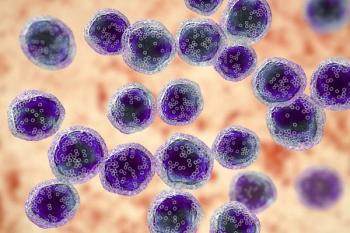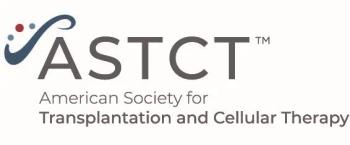
Oncology NEWS International
- Oncology NEWS International Vol 9 No 1
- Volume 9
- Issue 1
Specific Tyrosine Kinase Inhibitor Highly Active in CML
NEW ORLEANS-STI 571, an investigational drug for the treatment of chronic myelogenous leukemia (CML), produced complete hematologic responses in all patients receiving higher doses, according to preliminary analysis of phase I data presented at the 41st Annual Meeting of the American Society of Hematology (ASH) (see illustration ). All participants had failed interferon-alfa therapy.
NEW ORLEANSSTI 571, an investigational drug for the treatment of chronic myelogenous leukemia (CML), produced complete hematologic responses in all patients receiving higher doses, according to preliminary analysis of phase I data presented at the 41st Annual Meeting of the American Society of Hematology (ASH) (see illustration ). All participants had failed interferon-alfa therapy.
In CML, a chromosomal translocation (the Philadelphia chromosome) results in an oncogene that produces the abnormal protein bcr-abl. This fusion protein has enhanced tyrosine kinase activity, resulting in the excessive proliferation of white blood cells characteristic of the disease.
Thus, an inhibitor of the abl protein tyrosine kinase would be predicted to be an effective and targeted therapeutic agent, said Brian J. Druker, MD, associate professor of medicine, Oregon Health Sciences University, Portland.
Preclinical studies initiated at Dr. Drukers laboratory and confirmed in numerous other labs have shown that STI 571, a signal transduction inhibitor, is a potent and selective inhibitor of the abl and bcr-abl tyrosine kinases, and that the agent selectively kills bcr-abl expressing cells in vitro and in vivo.
In addition, as an oral formulation, it is highly bioavailable. Dr. Druker noted that the agent has been shown to have a half-life of between 13 and 18 hours, suggesting that once-daily administration is appropriate.
Dr. Druker conducted the study in conjunction with Moshe Talpaz, MD, of M.D. Anderson Cancer Center, and Charles Sawyers, MD, of the Jonsson Cancer Center at UCLA, as well as scientists at Novartis Pharmaceuticals, which is developing the agent.
Inclusion criteria for the study were diagnosis with Ph-chromosome-positive CML in the chronic phase of the disease with blast percentages in peripheral blood or bone less than 15%. Interferon failure was defined as 3 months of therapy without a hematologic response, or 1 year on interferon therapy without a cytogenic response, or acquired hematologic or cytogenic response that has been lost. In addition, some (less than 10%) interferon intolerant patients were enrolled.
A total of 61 patients (36 male, median age 57) participated in the study. The median duration of disease in the cohort was 3.7 years. Participants received once-daily oral doses of STI 571 at 11 dose levels ranging from 25 mg to 600 mg. No other cytoreductive agents were allowed. At the time of this report, the median duration of treatment was 190 days, with some patients on therapy for well over a year (up to 439 days).
New Trials of STI 571
Novartis Pharmaceuticals has initiated a phase II clinical trial of STI 571 for the treatment of CML in patients refractory to or intolerant of interferon. The study will be conducted at 19 sites throughout the United States and Europe.
Additional trials evaluating STI 571 in combination with chemotherapy agents are planned for patients with advanced stage CML and for those with Ph-chromosome-positive acute lymphocytic leukemia (ALL). A trial in pediatric patients is scheduled to open for enrollment in early 2000.
For more information about these studies, contact the Novartis Oncology Clinical Trials Hotline at 1-800-340-6843, or the companys website
Hematologic Responses
Hematologic responses (defined as a 50% decrease in white blood cell count from baseline maintained for a least 1 month) were seen among all 51 patients receiving doses of 140 mg or greater. Complete hematologic responses (defined as normal white blood cell and platelet counts maintained for at least 4 weeks), however, were not observed until doses of 200 mg or greater were reached, Dr. Druker said.
All patients receiving 300 mg or more (31/31) had a complete hematologic response. The white blood cell counts fell into the normal range within 3 to 4 weeks and were maintained throughout the duration of therapy, Dr. Druker said.
Cytogenic responses have been observed in 35% of patients on the higher dose (greater than 300 mg). Dr. Druker noted that cytogenic responses have been observed among 45% (9/20) of those with at least 5 months of treatment.
It is noteworthy that, first, it is possible to have a minimal response at 5 months with a major response at 8 months; second, in general, cytogenic responses have improved over time; and third, at 5 months, the majority of cytogenic responses are major responses, Dr. Druker said. He observed that three patients at 5 months follow-up were 100% Ph-chromosome negative.
Adverse Events
Dr. Druker said that a maximally tolerated dose has not yet been defined. He noted that the majority of patients at doses of 140 mg and greater have had decreases in hemoglobin of 1 to 2 g/dL. With continuing therapy, levels typically return to baseline or above baseline levels, he said.
Among the 31 patients being treated at a dose of 300 mg or higher, grade 2 myelosuppression has been seen in six patients and grade 3 in three patients. However, myelosuppression may be an indication of therapeutic benefit rather than toxicity in this patient population, Dr. Druker pointed out.
Adverse events have included grade 1 nausea (when taken on an empty stomach) in 40% of patients, and muscle cramps, arthralgia, and periorbital edema, each in 10% of patients.
Dr. Druker concluded that STI 571 has been well tolerated as an oral agent among CML patients refractory to other therapies. He emphasized that at least one third of the cohort had several disease criteria that would meet accelerated phase definitions. He cautioned, however: Despite these exciting results, I will be the very first to admit that we still have a lot to learn about this agent. We clearly dont know how durable the responses will be, if we will see the emergence of resistance, or if there will be any long-term unanticipated side effects.
Articles in this issue
almost 26 years ago
New Strategies for Treating Ovarian Canceralmost 26 years ago
Researchers See More Effective Lung Cancer Screening, Therapyalmost 26 years ago
Goserelin Reduces Breast Ca Recurrence in Younger Womenalmost 26 years ago
ODAC Recommends Approval of Targretin for Advanced CTCLalmost 26 years ago
IOM Assessing Early Breast Cancer Detection Technologiesalmost 26 years ago
CRFA Honors Three With Its 1999 FrontLine Awardsalmost 26 years ago
Aromasin, New Hormonal Agent, Approved for Breast Canceralmost 26 years ago
LEDs Developed by NASA Used to Ablate Brain Tumorsalmost 26 years ago
Early Androgen Deprivation Beneficialalmost 26 years ago
Higher-Dose RT May Improve Prostate Cancer OutcomeNewsletter
Stay up to date on recent advances in the multidisciplinary approach to cancer.


















































































